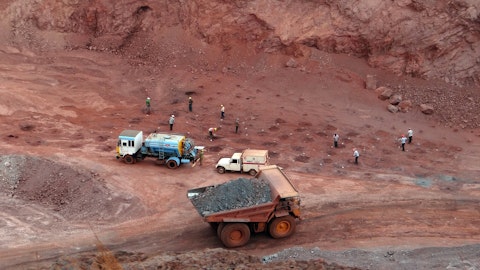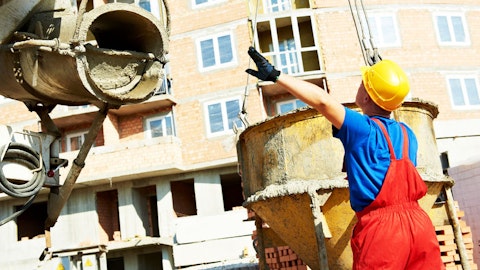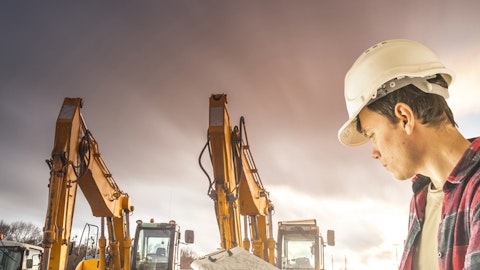Concrete Pumping Holdings, Inc. (NASDAQ:BBCP) Q4 2023 Earnings Call Transcript January 11, 2024
Concrete Pumping Holdings, Inc. reports earnings inline with expectations. Reported EPS is $0.16 EPS, expectations were $0.16. BBCP isn’t one of the 30 most popular stocks among hedge funds at the end of the third quarter (see the details here).
Operator: Good afternoon, everyone, and thank you for participating in today’s conference call to discuss Concrete Pumping Holdings Financial Results for the Fourth Quarter and Fiscal Year ended October 31, 2023. Joining us today are Concrete Pumping Holdings CEO, Bruce Young; CFO, Iain Humphries; and the company’s External Director of Investor Relations Cody Slach. Before we go further, I would like to turn the call over to Mr. Slach to read the company’s Safe Harbor Statement within the meaning of the Private Securities Litigation Reform Act of 1995 that provides important cautions regarding forward-looking statements. Cody, please go ahead.
Cody Slach: Thanks, Camilla. I would like to remind everyone that in the course of this call to give you a better understanding of our operations, we will be making certain forward-looking statements regarding our business and outlook. These statements are subject to numerous risks and uncertainties that could cause actual results to differ materially from such statements. For information concerning these risks and uncertainties, see Concrete Pumping Holdings annual report on Form 10-K, quarterly report on Form 10-Q, and other publicly available filings with the SEC. The company disclaims any intention or obligation to update or revise any forward-looking statements, whether as a result of new information, future events, or otherwise.
On today’s call, we will also reference certain non-GAAP financial measures, including adjusted EBITDA, net debt, and free cash flow, which we believe provide useful information for investors. We provide further information about these non-GAAP financial measures and reconciliations to the comparable GAAP measures in our press release issued today or the investor presentation posted on the company’s website. I’d like to remind everyone that this call will be available for replay later this evening. Webcast replay will also be available via the link provided in today’s press release, as well as on the company’s website. Additionally, we have posted an updated investor presentation to the company’s site. Now I’d like to turn the call over to the CEO of Concrete Pumping Holdings, Bruce Young.
Bruce?
Bruce Young: Thank you, Cody, and good afternoon, everyone. We had another strong year in fiscal 2023, driven by the strength and diversification of our business. As a result, we were able to drive financial performance records for annual revenue, adjusted EBITDA, and net income. Looking at our full fiscal year of 2023, revenue increased 10% to $442 million, adjusted EBITDA increased 7% to $125 million, and net income increased 12% to $30 million. Each of our end markets contributes to this performance, particularly as residential construction remains strong and our expanded footprint enabled us to continue to win infrastructure projects. We also continue to execute on our debt reduction initiative, achieving our 3 times leverage ratio target at the end of the 2023 fiscal year.
Shifting to our fourth quarter performance by end market, our business performed in line with expectations. In the infrastructure end market, our expanded US national footprint continued to drive strong results as we captured more revenue from public project investments. We continue to see more investment flowing to numerous projects where we operate and we plan to aggressively pursue these project opportunities with the belief that it has the potential to be a five-year plus tailwind for our business. During the fourth quarter, our residential end market remained stable due to the continued momentum in new residential housing construction, given not only the ongoing structural supply, demand imbalance in housing, but the fact that home builders have enticed a new home buyer with creative home design and financing options.
With interest rates falling subsequent to quarter end and the projection of additional interest rate cuts in 2024, we expect residential housing projects to remain healthy for our business. In the commercial end market, we continue to experience momentum in larger commercial projects like distribution centers, warehouses, semiconductor fabrication plants, and electric vehicle and battery manufacturing plants. We expect this demand to continue given U.S. reshoring trends as companies look to build out their domestic manufacturing footprint. However, concrete pumping demand from light commercial projects has continued to be comparatively weaker as interest rate sensitivity and reduced availability of financing from smaller regional banks has stalled some projects.
We expect that interest rate cuts in 2024 could help get these projects moving again. During the quarter, our commercial mix as a percentage of our total revenue declined 100 basis points year-over-year to 59%. This was fully absorbed by our infrastructure projects, while residential was flat year-over-year at 29%. This once again highlights the diversity of our business and the agility of our fleet. Shifting to the cost side of our business, persistent inflationary pressures, particularly in labor, continue to hamper our ability to flow through our strong revenue performance to the bottom line margin. We estimate labor inflation accounted for roughly half of the inflationary headwinds we experienced in our P&L. While we expect these headwinds to continue into the new year, we are confident the measures we are taking to recalibrate rates and the systems we are implementing to attract and retain our employees are the right steps for our business to drive long-term shareholder value.
I will now let Iain walk through more details of our financial results before we return to provide some concluding remarks. Iain?

Iain Humphries: Thanks, Bruce, and good afternoon, everybody. In the fourth quarter, revenue increased 5% to $120.2 million compared to $114.9 million in the same year ago quarter. The increase was mainly attributable to growth across each of our segments, as a result of organic growth from higher volumes in certain regions and improved pricing. Revenue in our US concrete pumping segment, mostly operating under the Brundage-Bone brand, increased 1% to $85 million compared to $84.3 million in the prior year quarter. For our UK operations, operating largely under the Camfaud brand, revenue improved 17% to $17.4 million compared to $14.9 million in the same year-ago quarter. When excluding the foreign exchange translation effects from the British pound, revenue for our UK operations increased approximately 10% in the fourth quarter, due primarily to pricing improvements.
Revenue in our U.S. Concrete Waste Management Services segment operating under the Eco-Pan brand increased 15% to $18 million compared to $15.6 million in the prior year quarter. The strong organic increase in revenue was driven by increases in volume and sustained improvement in pricing. Returning to our consolidated results, gross margin in the fourth quarter was 40.7% compared to 42.3% in the same year-ago quarter, with the decreased margin mostly being related to the impact of labor inflation. General and administrative expenses in the fourth quarter were roughly flat at $29.6 million compared to $30.3 million in the same year ago quarter. As a percentage of revenue, G&A costs improved in the fourth quarter to 24.6% compared to 26.4% in the same year ago quarter.
For the full year of 2023, when excluding the non-cash G&A expenses for amortization and stock-based compensation, G&A costs as a percentage of revenue were approximately 21%, which is consistent with the prior year. Net income available to common shareholders in the fourth quarter increased 11% to $9 million, or $0.16 per diluted share, compared to $8.1 million, or $0.14 per diluted share in the same year ago quarter. Consolidated adjusted EBITDA in the fourth quarter increased marginally to $35.8 million compared to $35.6 million in the same year ago quarter. Adjusted EBITDA margin was 29.8% compared to 31% in the same year ago quarter. And as discussed previously, the slight erosion in the margin was driven by persistent cost inflation, particularly in the cost of labor.
In our U.S. concrete pumping business, adjusted EBITDA decreased 7% to $21.2 million compared to $22.7 million in the same year ago quarter. In our UK business, adjusted EBITDA increased 9% to $5.1 million compared to $4.7 million in the same year ago quarter. For our U.S. Concrete Waste Management business, adjusted EBITDA increased 16% to $8.8 million compared to $7.6 million in the same year ago quarter. Turning now to free cash flow and liquidity. For the full year of 2023, we delivered 23% growth in free cash flow to approximately $69 million, which is compared to $56 million in the prior year. This is after investing approximately $29 million in replacement equipment and dispersing almost $27 million in cash interest. At October 31, 2023, we had total debt outstanding of $394 million or net debt of $378 million, a decrease of $42 million over the course of the year, which is a testament to our strong free cash flow generation.
This equates to a net debt to EBITDA leverage ratio of 3 times, which was our guided target for the 2023 year end. We had approximately $217 million of liquidity as of October 31, 2023, which includes cash on the balance sheet and availability from our ABL facility. As a reminder, we have no near-term debt maturities with our senior notes maturing in 2026 and our asset-based lending facility maturing in 2028. We remain in a strong liquidity position which provides further optionality to responsibly pursue value-added investment opportunities like a creative M&A or the organic investment in our fleet equipment to support our overall long-term growth strategy. During the third quarter of 2022, we entered into a share repurchase program to authorize the buyback of up to $10 million of our outstanding shares of common stock.
In January of 2023, the Board of Directors approved an additional $10 million increase. During the fourth quarter of 2023, under our share repurchase program we repurchased approximately 34,000 shares of our common stock for a total of approximately $240,000 at an average price of $7.08 per share. During fiscal years 2023 and 2022, under our share repurchase program, we repurchased approximately 1.7 million shares of our common stock for a total of $11.6 million or an average price of $6.57 per share. The current share buyback program is authorized by the Board of Directors through March of 2025 and we believe this demonstrates both our commitment to delivering value to our shareholders and our confidence in our strategic growth plan. Moving now into our 2024 full year guidance.
We expect fiscal year revenue to range between $465 million and $490 million, adjusted EBITDA to range between $127 million and $137 million, and free cash flow which we define as adjusted EBITDA less net replacement CapEx and less cash paid for interest to be at least $75 million. For fiscal year 2024, we expect to be impacted by continued inflationary cost pressures, primarily labor and insurance costs, and expect to offset these costs from the continued rate recalibration and cost efficiency initiatives. Operationally and financially, we continue to have a solid foundation and we have confidence in continuing to execute on our growth strategy. With that, I’ll now turn the call back over to Bruce.
Bruce Young: Thanks, Iain. In summary, we are incredibly pleased with a record year of revenue and EBITDA accompanied by expansion in every segment. We anticipate ongoing growth in our residential and infrastructure end markets, particularly driven by infrastructure projects and a resilient backlog of residential work. On the cost side of the equation, we are focused on attracting and retaining the best talent in the industry, while reducing the impact from inflationary cost pressures through rate increases. As always, our focus remains on optimizing end market mix to continue to deliver strong top and bottom line growth. Looking ahead, we believe our end market diversity and mission critical service in the construction industry positions us well for continued growth.
We expect to complement organic growth by continuing to evaluate opportunistic creative M&A, while strategically reducing our leverage. With that, I would now like to turn the call back over to the operator for Q&A. Camilla?
See also 25 Drunkest Countries in Asia and 26 Most Expensive Alcoholic Drinks In The World.
Q&A Session
Follow Concrete Pumping Holdings Inc. (NASDAQ:BBCP)
Follow Concrete Pumping Holdings Inc. (NASDAQ:BBCP)
Operator: Thank you, sir. We will now be conducting a question-and-answer session. [Operator Instructions] Thank you. And our first question will come from the line of Brent Thielman with D.A. Davidson. Please proceed with your question.
Brent Thielman: Hey, great. Thanks. Good afternoon. I guess, Bruce or Iain, first question is just the labor inflation. It still looks like it’s presenting some compression in the margin on U.S. pumping. Is the proportion of lower margin revenue in that segment, I guess, still shrinking as new business sort of better reflects today’s labor cost environment or we still sort of two or three quarters away from seeing some sort of an inflection in margins in that business group. Just be helpful to get your thoughts there.
Iain Humphries: Yes, Brian, good question. Yes, I mean, in short, it is shrinking. So a couple of points on that. And this is obviously part of — we mentioned cost initiatives in our prepared remarks. So the labor portion of that is certainly a big feature. I mean, as Bruce mentioned, about half of the inflation we’ve seen this year has been around labor, so it’s certainly one of our key focuses. So the margin impact is certainly shrinking, but still some work to do, and those are a big part of the cost initiatives going forward.
Bruce Young: Hi, Brent. I think what I would add to that is, it is shrinking now and it will continue to get better as we — as the year plays out.
Brent Thielman: Okay, that’s great. I mean the outlook for revenue for 2024, I mean, does call for reasonably healthy growth. I mean, just in light of kind of the moving pieces of the market. And I guess, also the fact that you did see some moderation in US pumping growth this quarter, maybe relative to what you’ve seen in terms of growth rates there. So I guess, Bruce, can you just sort of bridge what you anticipate for this new fiscal year, the confidence that you see some re-acceleration in growth in U.S. pumping?
Bruce Young: Yes, and as you know, because we operate under so many different geographies, that it’ll be different in different markets. But what we’re seeing is and what we’re working very hard on is getting rates up in markets where we can and maybe it’s different end markets, different customers, different sizes of equipment, things that we’ve been able to analyze that we need to do a little bit better on. We think we’ll drive that. And we also see some opportunities and some fairly large projects that we’re on to now that will be impactful to our revenues growing over the next year. But it’s always the same. It’s just holding our share, gaining share, kind of winning the battles in the trenches.
Brent Thielman: And Bruce, so those large project is ones that you’ve effectively been awarded or you’ve got a high level of confidence you’re going to be attached to those?
Bruce Young: Yes, some that we’re currently on, some that we expect to be awarded to us, and others that we’ll be bidding shortly.
Brent Thielman: Okay. And just my last question. I mean, nice work getting into the 3 times this year. I guess any further thoughts on where you want to be in 2024 with the balance sheet leverage?
Iain Humphries: Yes. I mean, obviously, the starting point, as you know, Brent, for us is the free cash flow number. And so again, we’re coming out with what we think is quite a strong indication of free cash flow. But consistent with the things, we’re always looking for the best opportunity to create the most shareholder value. So we’ll continue to allocate from a capital allocation perspective that free cash flow into the growth of the business in the areas that have the most value. A lot of it, obviously, in Eco-Pan is organic, but we also have the inorganic M&A opportunities if the values are right. So there’s a number of options, we think, from that free cash flow number to keep on doing the things that we have been doing.
Brent Thielman: Got it. Okay. I’ll pass it on. Thank you.
Bruce Young: Thanks, Brent.
Operator: Thank you. Our next question will come from the line of Andy Whitman with Baird. Please proceed with your question.
Andy Wittmann: Great and good afternoon, guys. Thank you for taking my questions. I guess, I just wanted to start with a question on the revenue outlook here for 2024. I guess, the implied growth right there is about 5% to almost 11%. I just wanted to kind of understand what’s in the low and the high end of the range. Is it fair to think of the low end being basically all price and flatish volumes and then volumes positive to get to the high end? Iain, is that one way of thinking about it? Is that the correct way of thinking about it? How are you thinking about it?
Iain Humphries: Yes, I think that’s fair, Andy. I think you’re right on. I mean, obviously, we’re doing continued rate recalibration, as we mentioned. But you’re right. On the low end, there is an assumption of flatter volume. And as we get to that midpoint, I mean, as you know, the split between volume and pricing can be somewhat equal. So if we talk just around the midpoint, it’s let’s say 3% or 5% on the volume, 3% or 5% on the price. And obviously that’ll flex based on the volume piece. So I think you’re thinking about it right.



